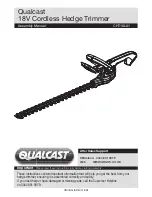
15
ENGLISH
Replacing the nylon cord
WARNING:
Use nylon cord with diameter
specified in “SPECIFICATIONS” only. Never use
heavier line, metal wire, rope or the like.
Use rec-
ommended nylon cord only, otherwise it may cause
damage to the tool and result in serious personal
injury.
WARNING:
Make sure that the cover of the
nylon cutting head is secured to the housing
properly as described below.
Failure to properly
secure the cover may cause the nylon cutting head to
fly apart resulting in serious personal injury.
1.
Press on the housing latches inward to lift off the
cover, then remove the spool.
►
Fig.26:
1.
Latch
2.
Cover
2.
Prepare approximately 3 m (9 ft) of new nylon
cord. Fold the new nylon cord with one end become
approximately 80 mm (3-1/8″) longer than the other
end. Then hook the new nylon cord into the notch in the
center of the spool.
Wind both ends firmly around the spool in the direction
of the head rotation (right-hand direction indicated by
RH on the side of the spool).
►
Fig.27:
1.
Spool
3.
Wind all but about 100 mm (3 - 15/16″) of the
cords, leaving the ends temporarily hooked through a
notch on the side of the spool.
►
Fig.28
4.
Mount the spool in the housing so that the grooves and
protrusions on the spool match up with those in the housing.
Keep the side with letters on the spool visible on the top. Now,
unhook the ends of the cord from their temporary position and
feed the cords through the eyelets to come out of the housing.
►
Fig.29:
1.
Spool
2.
Housing
3.
Eyelet
5.
Align the protrusion on the underside of the cover
with the slots of the eyelets. Then push the cover firmly
onto the housing to secure it.
►
Fig.30
Replacing the plastic blade
Replace the blade if it is worn out or broken.
►
Fig.31
When installing the plastic blade, align the direction of
the arrow on the blade with that of the protector.
►
Fig.32:
1.
Arrow on the protector
2.
Arrow on the blade
To maintain product SAFETY and RELIABILITY,
repairs, any other maintenance or adjustment should
be performed by Makita Authorized or Factory Service
Centers, always using Makita replacement parts.
TROUBLESHOOTING
Before asking for repairs, conduct your own inspection first. If you find a problem that is not explained in the manual,
do not attempt to dismantle the tool. Instead, ask Makita Authorized Service Centers, always using Makita replace-
ment parts for repairs.
State of abnormality
Probable cause (malfunction)
Remedy
Motor does not run.
Battery cartridge is not installed.
Install the battery cartridge.
Battery problem (under voltage)
Recharge the battery. If recharging is not effective,
replace battery.
The drive system does not work correctly.
Ask your local authorized service center for repair.
Motor stops running after a little use.
Battery's charge level is low.
Recharge the battery. If recharging is not effective,
replace battery.
Overheating.
Stop using of tool to allow it to cool down.
It does not reach maximum RPM.
Battery is installed improperly.
Install the battery cartridge as described in this
manual.
Battery power is dropping.
Recharge the battery. If recharging is not effective,
replace battery.
The drive system does not work
correctly.
Ask your local authorized service center for repair.
Cutting tool does not rotate:
stop the machine immediately!
Foreign object such as a branch is
jammed between the protector and the
cutting tool.
Remove the foreign object.
The drive system does not work
correctly.
Ask your local authorized service center for repair.
Abnormal vibration:
stop the machine immediately!
One end of the nylon cord has been
broken.
Tap the nylon cutting head against the ground while
it is rotating to cause the cord to feed.
Plastic blade(s) is broken.
Replace broken plastic blade(s) with new one(s).
The drive system does not work
correctly.
Ask your local authorized service center for repair.
Cutting tool and motor cannot stop:
Remove the battery immediately!
Electric or electronic malfunction.
Remove the battery and ask your local authorized
service center for repair.
Summary of Contents for DUR189RF
Page 2: ...Fig 1 Fig 2 Fig 3 2 3 1 6 7 8 9 10 11 12 13 12 4 5 Fig 4 2 ...
Page 3: ...1 2 3 Fig 5 1 2 Fig 6 1 Fig 7 2 1 Fig 8 1 Fig 9 1 Fig 10 1 Fig 11 1 2 Fig 12 3 ...
Page 4: ...1 2 3 4 5 Fig 13 Fig 14 1 3 1 4 2 4 3 3 2 Fig 15 1 2 2 1 Fig 16 Fig 17 1 2 Fig 18 4 ...
Page 5: ...Fig 19 6 5 1 2 3 4 Fig 20 1 2 3 4 5 Fig 21 1 Fig 22 Fig 23 2 1 Fig 24 1 Fig 25 5 ...
















































